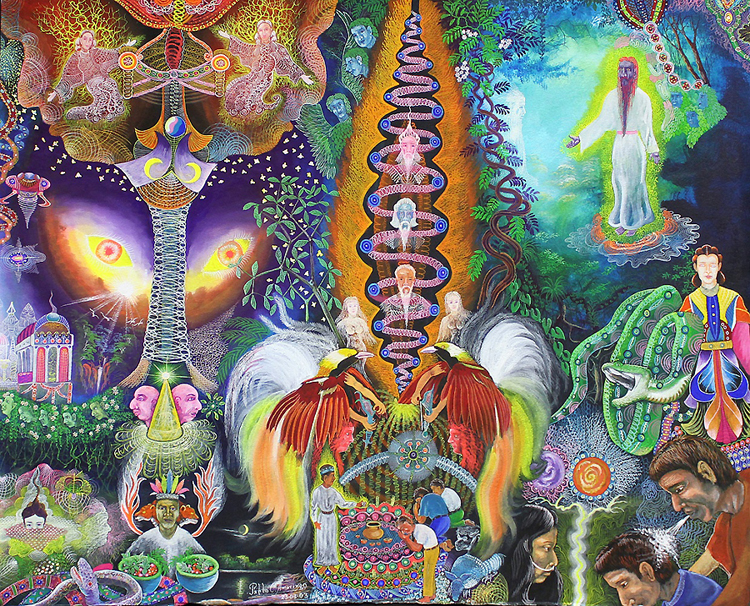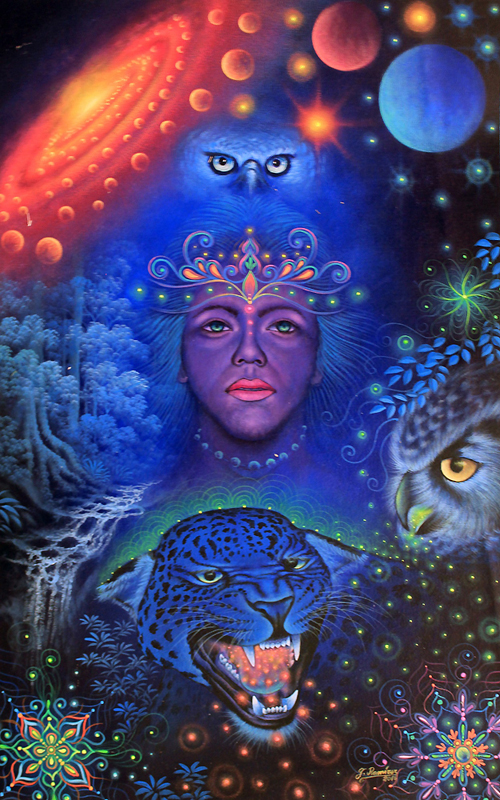|
|
|||
|
|||
| The
Rain Forest Comes to New Haven By Alan Bisbort Alan Bisbort is
a writer, editor, and researcher who has authored or coauthored sixteen
books of art, history, music, and travel and contributed to numerous
other books. His work has appeared in the New York Times, Washington
Post, Rolling Stone, In These Times, Los Angeles Times, Hartford Advocate,
and many other publications. Still, little can prepare viewers for the work that will appear at the Da Silva Gallery in New Haven in May 2018, from Scott Olsen’s collection of paintings and prints by Amaringo and the students of his Usko-Ayar School of Painting, such as Felix Pinchi Aguirre, Alfredo Zagaceta Cometivos, Jorge Enrique Ramirez Flores, Ener Fias Nunez and Ruisen Flores. Olsen, a University of Florida philosophy professor, spent nearly two decades traveling to the rain forest and Amazon headwaters of Peru to explore this art and the shamanic tradition that inspired it. He is the author of Mysteries of the Amazon: Visionary Artwork of Pablo Amaringo and his Students, which offers a visual sampling as well as a chronicle of his trips to the Incan strongholds in Peru. Take “Conocimientos Curvos (Curved Knowledge)”, which Amaringo painted in 2003. With Bosch-like detail and a palette that redefines what greens and blues can do on a canvas, the artist creates a multidimensional universe that embraces the spirits that vision masters like Amaringo find in the rain forest. Even when the meaning of the work is not immediately (if ever) knowable, the viewer simply cannot take his eyes off of it. Not to trivialize the work, but it is this quality that renders much of the psychedelic art of the 1960s so timeless. The power of the images are just as strong now, 40 and 50 years later, that they were at the time of their creation. They are—like the work of Amaringo and his disciples—not affixed to any artistic school or trend. They just are.
Exhibition May
11 - June, 2018 (extended). |
|||
|
**************************************************************************************************
|
|||
CURRENT ART EXHIBIT AT THE DASILVA GALLERY OFFERS PROFOUND ENCOUNTERS WITH ART & THE MYSTICAL STATES OF THE PERUVIAN SHAMANS When you unite the talents and experience of three eminently qualified professionals -- a first-rate art curator, a worldly and well-seasoned professor and a highly regarded local gallery owner -- you almost always come up with an art show that simply cannot be missed. Such is the art show on Peruvian shamanism presently on exhibit at the locally famed DaSilva Gallery in New Haven's Westville section thanks to the efforts of well-respected art curator Johnes Ruta. Until May 31, 2018, the show entitled "The Magical Mystery of Shamanism" will festure the magnificent works of the late vegetalista curandero of the mestizo tradition, Pablo Amaringo, who passed in 2009, and his students. Amaringo and the students of Amaringo's Usko-Ayar school of painting created these visionary artworks from their experiences deep in the rainforest of Peru after ingesting ayahuasca, an entheogenic concoction comprised of plant derivatives. At the Gallery's opening, the collection's owner, Scott Olsen, Professor Emeritus at the College of Central Florida, Ocala, who is well-versed and well-experienced in the ways of the ayahuasceros asserted that this concoction is "the fastest way to die to the ego." He explained that ingestion of ayahuasca really is a "dry run at death" as one attains supernormal perception allowing for profound encounters with plants, animals and ultimately, the Logos. Upon viewing these incredible artworks, there seems to be no question that these deep mystical states are precisely what Amaringo and his students have in fact experienced during their vision quests. Central to the exhibit is Pablo Amaringo's painting, "Curved Knowledge," which invites the viewer to follow a serpentine path that ascends in both knowledge and divinity. At the bottoms of the painting, we watch as retreat participants are depicted ingesting ayahuasca or having its smoke blown into the palm of their hands or on the nape of the neck by other retreat participants. Then the visual odysseys begin as we first encounter animals and plants and then our eyes rise to meet ascended masters, diving beings and even sacred geometric forms at the painting's top. And without eschewing the importance of the artistic and culturally iconic masterpiece that "Curved Knowedge" clearly is, each and every painting of Amaringo's students depicted in the exhibit are visionary masterpieces of their own. The purples, blues, greens, reds, oranges and yellows in all of these paintings are just so saturated that to view these paintings offers an experience with synesthesia. For no longer do you only "see" the rich colors but you and I can actually "feel" and "hear" the colors as they vibrate with unrelenting intensity. Spirit animals like the owl, the eagle, the cheetah and especially, the jaguar are common in these paintings as is the lush vegetation of the Peruvian rainforest. Indeed, visionary paintings such as these are not typically found on the walls of most museums in the Western hemisphere. And according to Professor Olsen, the reason rests primarily in the fact that most of Western civilization is immersed in a dark and destructive energy that is pulling us from nature and our innate divinity. Far from being protectors of "Mother" nature, Western civilization has cast itself far afield of the Divine Feminine. Most of the populations of the Western hemisphere have become saboteurs of this beautiful planet and in losing our relationship with "Mother" nature we have virtually lost our connection to what the plants and animals can teach us about attaining the Logos. Perhaps, there is no wonder that even in Christian societies most apparitions of the Logos (Jesus) and Divine beings such as the Virgin Mary manifest primarily amidst simple, indigenous and agrarian populations where there remains an intimate and enduring relationship with nature. The apparitions of the Virgin Mary in Fatima, Portugal to the shepherd children, Francisco and Jacinta Marto and their cousin, Lucia Santos, are prime examples. Undoubtedly, there is much to the belief that there is no way to the Father/the Son but through the Mother. And yet, according to Professor Olsen, the rigors of pursuing an ayahuasca retreat are many. Not only is the Peruvian rainforest far removed from the usual comforts of civilization but the average Westerner would probably be ill-advised to even entertain the possibility of such a journey. Professor Olsen advised that the ayahuasceros require a diet of extreme physical and sensual deprivations in order to prepare the body for such a profound activation of the third eye chakra. But, a short trip to the DaSilva Gallery is certainly in order where you can enter a meditative state just by fixating on one of these magnificent artworks. Enter by the jaguar's mouth, the mouth of the cheetah or the headwaters of the Amazon. You won't be disppointed. Authored by Donna Marie Joyce Copyright 2018 |
|||
|
|
|||
|
**************************************************************************************************
|
|||






